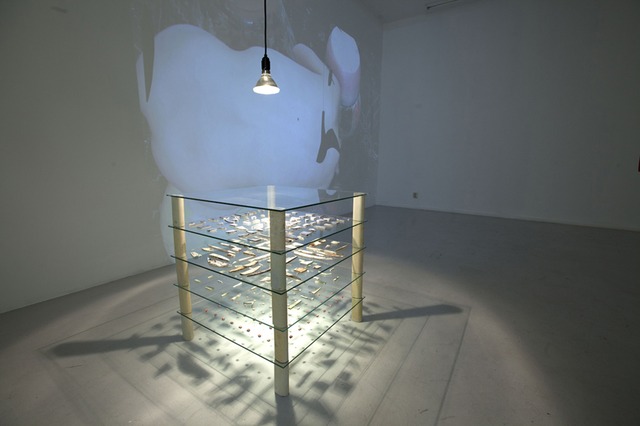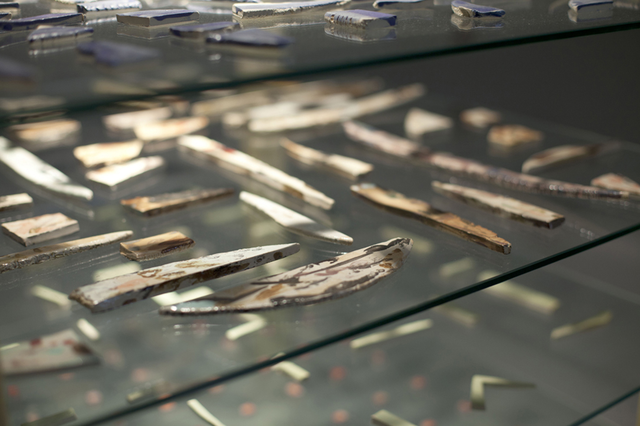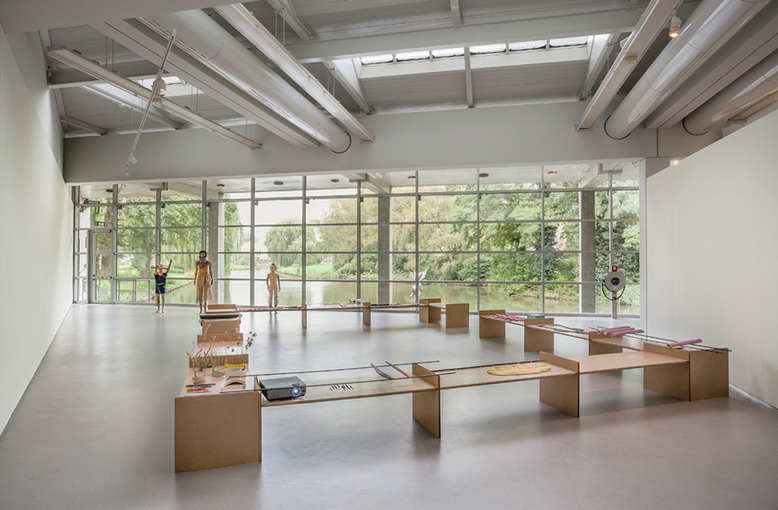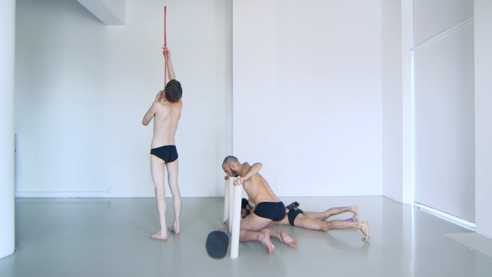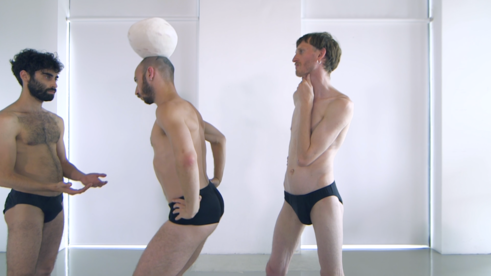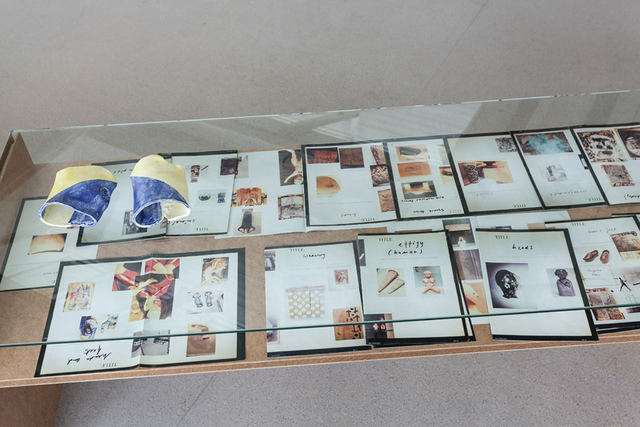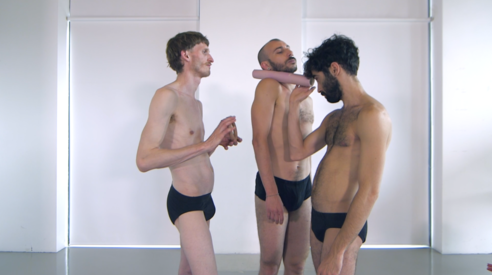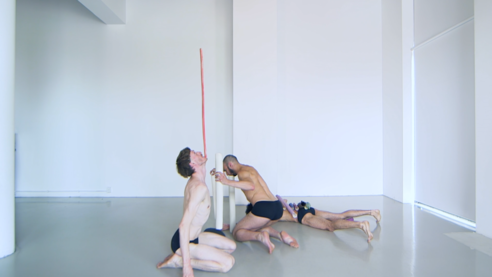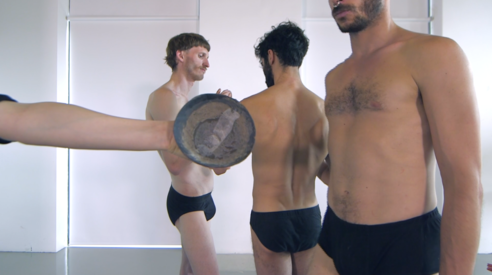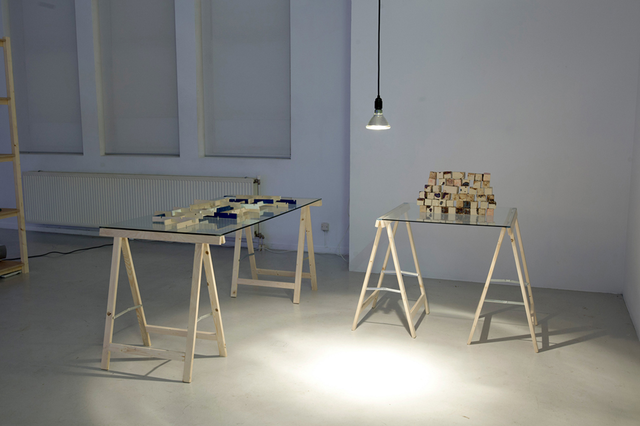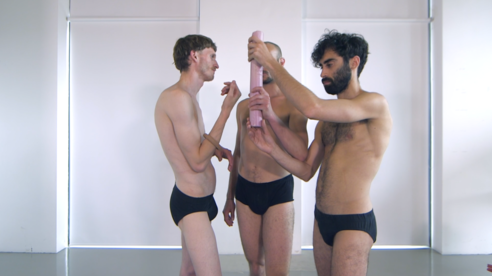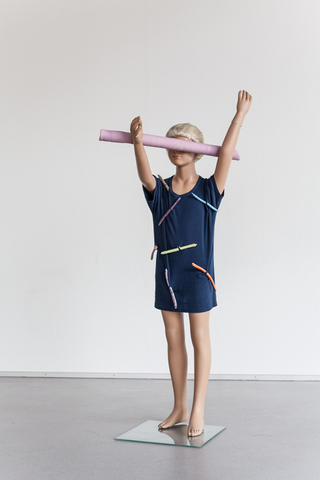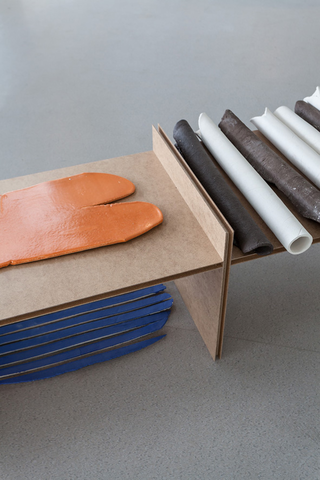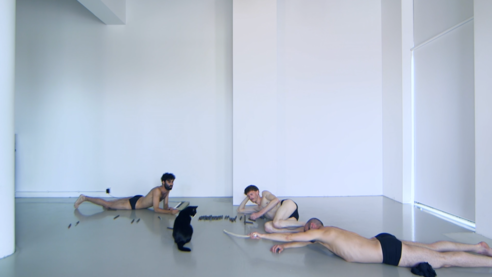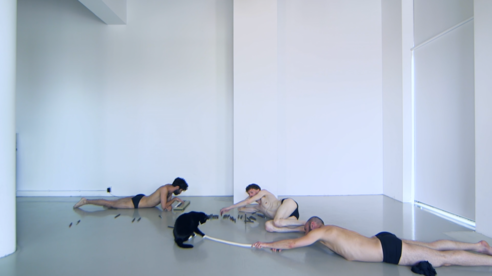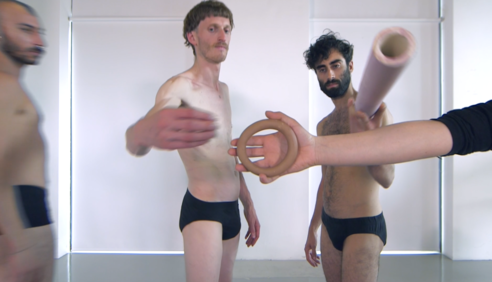Fragile compositions
For the materialist artist, human thought processes are instigated by the substances themselves, and are synonymous with the reaction form which these same substances have.
– Asger Jorn[1]
Coming back to A Way of Making, I would like to turn now to the different registers in which rudimentariness is staged throughout the various facets of Bergholtz and Pask’s practice. So far I have focused on their experiments in clay. However, as making is their site of investigation, it is crucial to their overall project that what they learn and experience in making ceramics can be translated into making other kinds of artworks, including the making of exhibitions. They have therefore experimented with ways of sharing what they are busy with, of seeing how their encounters with clay can be extended to the creation of sensate encounters for others. In their words, ‘we didn’t want to step into the conventional procedure of conceptualizing a show, instead we wanted to follow and extend the grooves the clay-exercises were bringing us into – exercises that postponed a fixed form, or a placement of these forms.’[2]
The placement of works in the shows can be characterised as a kind of composition, in which objects stand as singular artistic pieces but also contribute to imparting underlying features of the makers’ artistic process and research. The objects presented in the exhibitions were largely non-functional and abstract, not pointing to anything beyond themselves. They confront the viewer first with their materiality and formal aspects, which have no readily prescribed meaning. And with their composition also, because in both shows the makers made everything: the works, the structures on which they are shown, the video installations, and the lighting – each contributes to forming a whole. Behind every element there is a sense of great care, but also a sense of fragility, in an attempt to stay close to the aesthetics that have emerged in the artists’ investigation of making.
In the first show at Ellen de Bruijne Projects (2013), works were displayed in clusters on simple glass tables and wooden shelving. A creative use of lighting gave the individual objects a kind of archaeological feel, in which they performed both as ceramic pieces and as scientific data. In the second show at the Cobra Museum (2014), Bergholtz and Pask created a set of low shelving to present their subsequent body of work. The structure formed two large brackets and interpolated the visitor somatically; it functioned simultaneously as an exhibiting structure and as a bench on which one could sit down and come physically closer to the exhibited works.
The video pieces occupy a specific role in Bergholtz and Pask’s overall project. On two occasions, after producing a wide range of ceramics works, they invited performers to be the first to encounter, engage with, and respond to the works. Bergholtz and Pask were interested in how the performers’ exchanges with the works would affect their movement and potentially produce meaning.[3] In both cases these encounters were documented and turned into video installations. These works were presented in the particular exhibitions in which the ceramics in the video were concurrently on display.
In the first video shown at Ellen de Bruijne Projects, a naked woman is seen constantly rearranging a series of vases; her movements and compositions are confined to the surface of a Persian rug. What is already evident in this piece is the dialogue between the woman and the ceramics pieces, a constant arranging and rearranging, in which the woman responds bodily and through basic curatorial actions to the pieces around her.
I would like to focus on the second piece, which was projected in the far corner of the exhibition at the Cobra Museum. In this second public moment, A Way Of Making was framed within the context of the museum’s one hundred year commemoration of artist Asger Jorn’s birth. A Way of Making was among other projects chosen for its affinity with Jorn’s materialist practice.
The video installation was projected large scale on a white wall for which the low display structure functioned as a viewing bench. The white architectural space and grey floor in the projected image echoed that of the exhibition space, creating the illusion of continuity between the actual and virtual spaces. For this piece three men were asked to engage with the second body of ceramics produced by Bergholtz and Pask. In this installation, the entre-deux moment that occurs between a feeling body and the materiality of the objects with which it engages is poignantly visualised.
The fixed camera frame turns the space it captures literally into a stage, onto which the performers enter and exit with ceramics works they have chosen, works that seem to wait for them just outside the frame. The piece is divided into ‘movements’, each dedicated to the performers successive exploration of different ceramic objects. The footage is minimally edited and runs for over three hours, and yet the moments flow into one another in a seamless, entrancing fashion.
Wearing nothing but plain black underwear, the performers enter the frame with an object and begin their investigation: feeling its contour; listening to how it resonates as they drag it across the surface of the wall, the ground, or another piece; playing with how it sounds when it is used as a percussion or wind instrument; testing the object’s own movement, as it roles, swings, or is made to balance; or testing how its shape relates or contrasts to that of another body (that of a performer or another object).
The performer’s entire body is involved in the investigation, reacting to and extending what it discovers and feels through movements, gestures, and poses. The performers engage prosthetically with the elements, moving toward and simultaneously opening-up, causing the body to alter its dimensions. ‘I reach out to touch you in order to invent a relation that will, in turn, invent me.’[4] These words directed at two bodies engaged in the embrace in an Argentinean tango, echo forcefully with the dynamics of the video installation. Indeed, as time unfolds, ceramics become extensions of bodies, the bodies extensions of objects, each connecting and reconnecting to one another in a continuous, morphing manner.
In this piece, rudimentariness is the attitude of the performing subjects in relation to the objects they encounter. Their probing and inquisitive stance on the forms, shapes, and materials of the many objects imparts how tenuous it is for the subject to sustain such a disposition toward the ceramic objects that resist immediate grasping. What emerges in this piece is a fluctuating intensity of attention to – or, perhaps more aptly, of tension between – elements. In many instances the inquisitive stance of the performers produces a charged silence, in which the relation between them forms a striking formal configuration, moments when the entre-deux of the touching-being-touched is palpable. And then, something breaks. The bodies decontract and let go of their alertness; the composition they had temporally formed with the object disintegrates. In other moments, a movement is initiated and loses momentum or direction as it is not captured or followed through by another body. Occasionally, too, an action provokes a slippage provoking a jerky bodily retort, sending an element crashing down to the floor.
The experience for the visitor is forceful in so far as visual and audio information provoke a continual reviewing of the objects as well as the bodies. A distinct gesture will cause an object to take on a familiarity, suddenly appearing as a recognisable tool, as ceremonial garb, or as the perceptible sound of a horn or percussion instrument. The body also acquires new readings, becoming object-like as limbs echo a shape, or extend a dynamic line. In other moments, the adorning of the body with ceramic elements transfigures the performer, for example, into a majestic, queen-like figure. A degree of playfulness and humour invests the entire piece, which includes several impromptu entries by an errant cat. The point is that for the visitor, information constantly emerges into light and legibility only to plunge again into a struggle to make sense of what is being perceived.
What I have been calling rudimentariness is a fragile state or attitude that permeates the various facets of Bergholtz and Pask’s overall project. First, it qualifies the way in which the artists embrace their form of ignorance toward their site of investigation: the practice of making. The artists consciously attempt to dwell in ‘sheer innocence’ during their exploration of the many possibilities and facets of making in ceramics, which becomes the site from which they learn and are transformed. Second, rudimentariness is passed over to the artistic creations, in so far as they function at one and the same time as singular works and the accumulated data of the makers’ experiments. In keeping with their singular form of artistic research, Bergholtz and Pask attempt to share their work in a manner that extends what they have learned in practice: an aesthetic encounter with their medium in which a dialogic relation and sensate thinking predominates. Rudimentariness then becomes the perspective through which the subsequent bodies that encounter their work – both performers and visitors – are interpolated and positioned.
Rudimentariness and artistic research
[1] Asger Jorn, ‘What Is an Ornament?’ in Fraternité avant tout: Asger Jorn’s Writing on Art and Architecture, 1938–1958, ed. by Ruth Baumeister, trans. by Paul Larkin (Rotterdam: 010 Publishers, 2011), pp. 196–212 (p. 201).
[2] Frédérique Bergholtz and Maria Pask, ‘Letter to the Visitor’, visitor handout for exhibition A Way of Making, Cobra Museum, Amsterdam (2014).
[3] Bergholtz and Pask, ‘Letter to the Visitor’.
[4] Manning, p. xv.
